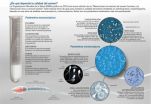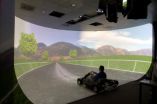(Press-News.org) A team of physicists from Europe and South Africa showed that electrons moving randomly in graphene can mimic the dynamics of particles such as cosmic rays, despite travelling at a fraction of their speed, in a paper about to be published in EPJ B.
Andrey Pototsky and colleagues made use of their knowledge of graphene, which is made of a carbon layer, one atom thick, and packed in a honeycomb lattice pattern. In such material the interaction of electrons with atoms changes the effective mass of the electrons. As a result, the energy of electrons in graphene becomes similar to the photon energy.
Therefore, electrons in graphene can be regarded as behaving like cosmic rays, which belong to a family known as ultra-relativistic particles, even though their actual velocity is one hundred times lower than the speed of light.
The authors employed the classical equations used to describe random motion—so-called Brownian motion—to study the dynamics of electrons within the confines of their graphene mini-laboratory. They considered different graphene chip geometries and subjected them to changing conditions that affect the way these electrons diffuse through the material, such as temperature and electric field strength.
Going one step further, the authors were able to rectify electron fluctuations and to control the electron motion itself, from an unusual chaotic type of motion to a periodic movement, by varying the electric field.
Future work would experimentally demonstrate how variation of the temperature can be used positively to enhance the performance of graphene chips by gaining a greater control over electron transport. Such graphene mini-labs could also ultimately help us to understand the dynamics of matter and anti-matter in cosmic rays.
###
Reference:
A. Pototsky, F. Marchesoni, F. V. Kusmartsev, P. Hanggi, and S. E. Savel'ev, Relativistic Brownian motion on a graphene chip, European Physical Journal B (2012) 85: 356, DOI: 10.1140/epjb/e2012-30716-7
For more information, please visit www.epj.org
The full-text article is available for journalists on request.
Graphene mini-lab
Physicists study fast-moving electrons in graphene as a model laboratory for massless particles
2012-10-31
ELSE PRESS RELEASES FROM THIS DATE:
First-ever 3-D stress map of developing embryonic heart sheds light on why defects form
2012-10-31
WASHINGTON, Oct. 31—As a human fetus develops, its heart has to keep pace with the new body's ever-growing demands. Much of this is controlled by following genetic blueprints, but the embryonic heart also matures in response to the intense stresses of pumping blood. For the first time, researchers have been able to visualize in 3-D the stresses induced by flowing blood in an embryonic heart. The technique, which promises to provide new insight into how and why heart defects develop, is described in a paper published today in the Optical Society's (OSA) open-access journal ...
Unlocking the secrets of DNA repair
2012-10-31
Scientists from the University of Sheffield have unlocked one of the secrets to DNA repair –helping doctors identify DNA base damage and a patient's susceptibility to certain types of cancer.
Groundbreaking research led by Dr David Williams from the University of Sheffield's Department of Chemistry and an international collaboration of expert researchers has discovered how some proteins recognise damaged bases within DNA which, if untreated, could lead to cancer.
Dr Williams said: "Proteins carry out all the day-to-day processes needed for survival. If the DNA bases ...
How and why herpes viruses reactivate to cause disease
2012-10-31
The mere mention of the word "herpes" usually conjures negative images and stereotypes, but most people have been infected with some form of the virus. For most, a sore appears, heals and is forgotten, although the virus remains latent just waiting for the right circumstances to come back. Now, the mystery behind what triggers the virus to become active again is closer to being solved thanks to new research published in the Journal of Leukocyte Biology's November 2012 issue. In the report, scientists show how the immune system may lose its control over the virus when facing ...
Men who do exercise produce better quality semen
2012-10-31
A new study conducted by researchers at the University of Cordoba links moderate physical activity in males with better hormone levels and sperm characteristics that favour reproduction compared to sedentary men.
Semen quality at large has dropped in the last 50 years. Amongst other factors, this is due to exposure to external agents and alcohol and tobacco consumption. This decline in sperm properties has caused an increase in reproductive problems.
Therefore, experts have studied the possible relationship between sperm quality and lifestyle habits in males. Published ...
Microscopic packets of stem cell factors could be key to preventing lung disease in babies
2012-10-31
Boston, Mass.—Researchers at Boston Children's Hospital have found that microscopic particles containing proteins and nucleic acids called exosomes could potentially protect the fragile lungs of premature babies from serious lung diseases and chronic lung injury caused by inflammation.
The findings explain earlier research suggesting that while transplanting a kind of stem cell called mesenchymal stem cells (MSCs) could help reduce lung injury and prevent inflammation in a mouse model, the fluid in which the cells were grown was more effective than the cells themselves.
The ...
Biofuel breakthrough: Quick cook method turns algae into oil
2012-10-31
ANN ARBOR—It looks like Mother Nature was wasting her time with a multimillion-year process to produce crude oil. Michigan Engineering researchers can "pressure-cook" algae for as little as a minute and transform an unprecedented 65 percent of the green slime into biocrude.
"We're trying to mimic the process in nature that forms crude oil with marine organisms," said Phil Savage, an Arthur F. Thurnau professor and a professor of chemical engineering at the University of Michigan.
The findings will be presented Nov. 1 at the 2012 American Institute of Chemical Engineers ...
Scientists unravel resistance to breast cancer treatment
2012-10-31
Scientists have identified a molecular 'flag' in women with breast cancer who do not respond or have become resistant to the hormone drug tamoxifen.
Tamoxifen – used alongside traditional chemotherapy and radiotherapy – blocks the female hormone oestrogen that, in certain breast cancers, is required by the tumour to grow; it has been shown to improve cancer survival rates by up to one third.
However, about one third of patients with the appropriate type of breast cancer – known as oestrogen receptor positive breast cancer – do not respond to tamoxifen or develop resistance ...
Foggy perception slows us down
2012-10-31
This press release is available in German.
Fog is an atmospheric phenomenon that afflicts millions of drivers every day, impairing visibility and increasing the risk of an accident. The ways people respond to conditions of reduced visibility is a central topic in vision research. It has been shown that people tend to underestimate speeds when visibility is reduced equally at all distances, as for example, when driving with a uniformly fogged windshield. But what happens when the visibility decreases as you look further into the distance, as happens when driving in ...
Social factors trump genetic forces in forging friendships, CU-led study finds
2012-10-31
"Nature teaches beasts to know their friends," wrote Shakespeare. In humans, nature may be less than half of the story, a team led by University of Colorado Boulder researchers has found.
In the first study of its kind, the team found that genetic similarities may help to explain why human birds of a feather flock together, but the full story of why people become friends "is contingent upon the social environment in which individuals interact with one another," the researchers write.
People are more likely to befriend genetically similar people when their environment ...
Team uses antisense technology that exploits gene splicing mechanism to kill cancer cells
2012-10-31
Cold Spring Harbor, N.Y. – Cancer cells grow fast. That's an essential characteristic of what makes them cancer cells. They've crashed through all the cell-cycle checkpoints and are continuously growing and dividing, far outstripping our normal cells. To do this they need to speed up their metabolism.
CSHL Professor Adrian Krainer and his team have found a way to target the cancer cell metabolic process and in the process specifically kill cancer cells.
Nearly 90 years ago the German chemist and Nobel laureate Otto Warburg proposed that cancer's prime cause was a change ...
LAST 30 PRESS RELEASES:
Why nail-biting, procrastination and other self-sabotaging behaviors are rooted in survival instincts
Regional variations in mechanical properties of porcine leptomeninges
Artificial empathy in therapy and healthcare: advancements in interpersonal interaction technologies
Why some brains switch gears more efficiently than others
UVA’s Jundong Li wins ICDM’S 2025 Tao Li Award for data mining, machine learning
UVA’s low-power, high-performance computer power player Mircea Stan earns National Academy of Inventors fellowship
Not playing by the rules: USU researcher explores filamentous algae dynamics in rivers
Do our body clocks influence our risk of dementia?
Anthropologists offer new evidence of bipedalism in long-debated fossil discovery
Safer receipt paper from wood
Dosage-sensitive genes suggest no whole-genome duplications in ancestral angiosperm
First ancient human herpesvirus genomes document their deep history with humans
Why Some Bacteria Survive Antibiotics and How to Stop Them - New study reveals that bacteria can survive antibiotic treatment through two fundamentally different “shutdown modes”
UCLA study links scar healing to dangerous placenta condition
CHANGE-seq-BE finds off-target changes in the genome from base editors
The Journal of Nuclear Medicine Ahead-of-Print Tip Sheet: January 2, 2026
Delayed or absent first dose of measles, mumps, and rubella vaccination
Trends in US preterm birth rates by household income and race and ethnicity
Study identifies potential biomarker linked to progression and brain inflammation in multiple sclerosis
Many mothers in Norway do not show up for postnatal check-ups
Researchers want to find out why quick clay is so unstable
Superradiant spins show teamwork at the quantum scale
Cleveland Clinic Research links tumor bacteria to immunotherapy resistance in head and neck cancer
First Editorial of 2026: Resisting AI slop
Joint ground- and space-based observations reveal Saturn-mass rogue planet
Inheritable genetic variant offers protection against blood cancer risk and progression
Pigs settled Pacific islands alongside early human voyagers
A Coral reef’s daily pulse reshapes microbes in surrounding waters
EAST Tokamak experiments exceed plasma density limit, offering new approach to fusion ignition
Groundbreaking discovery reveals Africa’s oldest cremation pyre and complex ritual practices
[Press-News.org] Graphene mini-labPhysicists study fast-moving electrons in graphene as a model laboratory for massless particles


